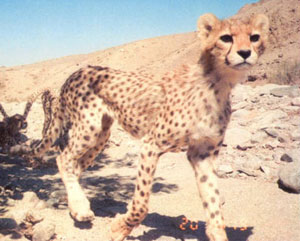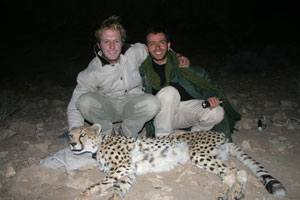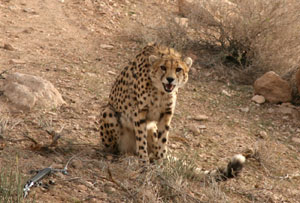Cheetahs in Iran?
Cheetah in Iran?
mongabay.com
March 1, 2007
Biologists from the Wildlife Conservation Society (WCS) have fitted critically endangered cheetahs in Iran with Global Positioning System (GPS) collars. This marks the first time this population of Asiatic cheetah can be tracked remotely.
WCS is working with the Iranian Department of Environment to protect the Asiatic cheetah found only in the extremely arid habitat around Iran’s Kavir Desert. The conservation groups that on 60-100 Asiatic cheetah remain in the wild, making it one of the world’s most endangered cats.
“This is an amazing milestone in securing the long-term future for the Asiatic cheetah,” said Wildlife Conservation Society biologist Dr. Luke Hunter, who led the international team. “We know very little about the important ecological needs of the species in Iran except that they require vast areas for their survival. Understanding their movements as they travel between reserves is one of the first steps in establishing a plan to secure and connect the few remaining populations of this incredible animal.”

Female Asiatic cheetah captured with a remote camera in Iran. Photo courtesy I.R.Iran DOE/CACP/WCS/ UNDP-GEF Phd Student Guy Balme (WCS) and Iranian vet Kamran Kashiri (CACP) celebrate the successful radio-collaring of the first Asiatic cheetah in Iran. Photo credit: WCS/DoE-CACP/ZSL/UNDP
A male cheetah held securely but gently in a soft-catch’ foot-hold snare. The technique is one of the safest ways to capture cheetahs and allows scientists to sedate the animals for radio-collaring; both recent captures took place without a hitch. Photo credit: WCS/DoE-CACP/ZSL/UNDP |
WCS notes that the population of the species has fallen significantly since the early years of the 1979 revolution in Iran.
“Once ranging from the Red Sea to India, the Asiatic cheetah today is hanging on by only the thinnest of threads,” WCS stated in a release. “In the 1970s, estimates of the number of cheetahs in Iran ranged from 100 to 400 animals. But widespread poaching of cheetahs and their prey during the early years of the 1979 revolution, along with degradation of habitat due to livestock grazing, have pushed this important predator to the brink of extinction. Historically cheetahs have played a significant role in Iranian culture, being trained by its emperors to hunt gazelles in ancient times.”
Elsewhere the Asiatic cheetah has gone extinct. WCS says that they disappeared from most of the Middle East about 100 years ago and India in 1947.
“These captures herald a new era of conservation in Iran,” added Dr Hooshang Ziaie, Iranian biologist and director of the project in Iran. “This is the first time we have successfully deployed these collars in Iran, and the data they provide will enable us to make very specific recommendations for conserving cheetahs for future generations. We are delighted that this international collaboration is producing such important outcomes.”
This article used quotes and information from a WCS news release

